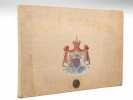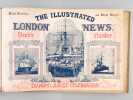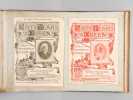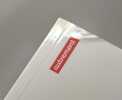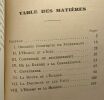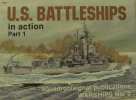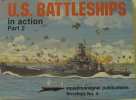808 books for « stern »Edit
-
Type
Autograph (1)
Book (742)
Music sheets (87)
Photographs (1)
Postcards (1)
-
Language
English (5)
French (813)
Hebrew (1)
Russian (13)
-
Century
18th (5)
19th (34)
20th (415)
21st (64)
-
Countries
Belgium (35)
Canada (6)
China (4)
Denmark (12)
France (681)
Germany (1)
Italy (2)
Netherlands (3)
Switzerland (73)
United Kingdom (2)
United States of America (13)
-
Syndicate
ALAC (6)
CLAM (2)
CLAQ (2)
ILAB (348)
NVVA (7)
SLACES (7)
SLAM (313)
SNCAO (1)
Topics
- Agoult marie d (12)
- Angkor (3)
- Archaeology (7)
- Architecture (12)
- Asia - orient (11)
- Astrology (10)
- Austria (3)
- Autographs (5)
- Biography (10)
- Castles (3)
- Cinema (9)
- Civilisation (6)
- Comic strip (6)
- Cooking (3)
- Culinary art (2)
- Dauphiné (2)
- Detective novels (4)
- Early printed books (7)
- Economics (2)
- Education (7)
- Education - morals (5)
- England (3)
- English (14)
- Esotericism (4)
- Ex-libris (4)
- Feminism (3)
- Fine arts (12)
- First edition (6)
- Fox (5)
- Geography (4)
- German history (2)
- Germanic languages (8)
- Germany (12)
- Germany pc (2)
- Grousset rené (3)
- Helvética (8)
- History (33)
- Hitler (3)
- Horse riding (4)
- India (19)
- Industrial arts & crafts - fine arts (9)
- Israel (3)
- Italian (5)
- Judaism (judaica) (3)
- Khmer art cambodia (7)
- Law (8)
- Literature (63)
- Mathematics (3)
- Medicine (9)
- Navigation (3)
- Navy (8)
- Nazism (3)
- Painting (3)
- Paris (10)
- Philosophy (12)
- Photography (18)
- Physics (8)
- Piano (2)
- Poetry (3)
- Policy (6)
- Posters (4)
- Psychoanalysis (5)
- Psychology (12)
- Raphael (4)
- Regionalism (2)
- Religions (5)
- Review (3)
- Revolution 1789 (4)
- Robin (3)
- Rock (3)
- Rock (3)
- Rollin (3)
- Sail (4)
- Sciences (2)
- Scores (94)
- Sculpture (3)
- Social sciences (2)
- Songs (80)
- Sports (2)
- Star (7)
- Stern jean (18)
- Stern philippe (9)
- Surgery (5)
- Switzerland (6)
- Theatre (14)
- Translation (4)
- United kingdom (6)
- Ussr (5)
- Various (11)
- Virgin mary (2)
- Waltz (6)
- War (7)
- Zoology (2)
Esquisses morales - pensées réflexions et maximes suivies des poésies de Daniel Stern précédées d'une étude biographique et littéraire par L. de Ronchaud - Oeuvres de Daniel Stern
Calmann lévy 1880 in12. 1880. Relié.
Bon Etat général couverture défraîchie bords frottés cuir éraflé par endroit qq rousseurs dans les plats intérieurs te sur la tranche reste propre bonne tenue de la reliure
Un procès "ordinaire" en U.R.S.S. Le Dr Stern devant ses juges - traduit du russe par Ania Chevallier
Gallimard 1976 in8. 1976. Broché.
Etat Correct
Jubilé de la Reine Victoria. 22 juin 1897. Album unique composé de documents collectés par Ernesta Stern dont : Plan de l'itinéraire de la procession ; 6 photographies par Downey, photographe de la Reine ; Portrait de la reine par Nicholson (gravure sur bois en couleurs) ; 3 invitations diverses ; Programme du Royal Opera Covent Garden du 23 juin 1897, sur soie à galons d'argent ("To commemorate the sixtieth anniversary of Her Majest's Accession to the Throne") ; 5 ephemera dont invitation de Lord Chamberlain à l'Afternoon Party du 28 juin 1897 à Buckingham Palace ("The Lord Chamberlain is commanded by The Queen to invite Monsieur & Madame Stern & Mademoiselle Stern to an afternoon Party on Monday, the 28th of June, from 5 to 7 o'Clock. Buckingham Palace") , etc... - Jubilee of Queen Victoria. June 22, 1897. Unique album composed of documents collected by Ernesta Stern including: Map of the route of the procession; 6 photographs by Downey, photographer to the Queen; Portrait of the Queen by Nicholson (colour woodcut); 3 various invitations; Program of the Royal Opera Covent Garden of June 23, 1897, on silk with silver braid ("To commemorate the sixtieth anniversary of Her Majest's Accession to the Throne"); 5 ephemera including Lord Chamberlain's invitation to the Afternoon Party of 28 June 1897 at Buckingham Palace ("The Lord Chamberlain is commanded by The Queen to invite Monsieur & Madame Stern & Mademoiselle Stern to an afternoon Party on Monday, the 28th of June, from 5 to 7 o'Clock. Buckingham Palace"), etc.
Album in-folio oblong (41 x 63 cm) pleine toile grise d'époque, armes d'Angleterre peintes sur le premier plat, médaille incrustée en bas du premier plat ("Victoria Regina et Imperatrix" à l'avers, "In Commemoration Victoria 1837-1897" au revers), Jubilé de la Reine Victoria. 22 juin 1897. Album unique composé de documents collectés par Ernesta Stern dont : Plan de l'itinéraire de la procession ; 6 photographies par Downey, photographe de la Reine ; Portrait de la reine par Nicholson (gravure sur bois en couleurs) ; 3 invitations diverses ; Programme du Royal Opera Covent Garden du 23 juin 1897, sur soie à galons d'argent ("To commemorate the sixtieth anniversary of Her Majest's Accession to the Throne") ; 5 ephemera dont invitation de Lord Chamberlain à l'Afternoon Party du 28 juin 1897 à Buckingham Palace ("The Lord Chamberlain is commanded bu The Queen to invite Monsieur & Madame Stern & Mademoiselle Stern to an afternoon Party on Monday, the 28th of June, from 5 to 7 o'Clock. Buckingham Palace") - Jubilee of Queen Victoria. June 22, 1897. Unique album composed of documents collected by Ernesta Stern including: Map of the route of the procession; 6 photographs by Downey, photographer to the Queen; Portrait of the Queen by Nicholson (colour woodcut); 3 various invitations; Program of the Royal Opera Covent Garden of June 23, 1897, on silk with silver braid ("To commemorate the sixtieth anniversary of Her Majest's Accession to the Throne"); 5 ephemera including Lord Chamberlain's invitation to the Afternoon Party of 28 June 1897 at Buckingham Palace ("The Lord Chamberlain is commanded bu The Queen to invite Monsieur & Madame Stern & Mademoiselle Stern to an afternoon Party on Monday, the 28th of June, from 5 to 7 o'Clock. Buckingham Palace")
Impressionnant album souvenir unique du Jubilé de la Reine Victoria, composé par Ernesta Stern (1854-1926) alias "Maria Star", écrivain fameuse pour son salon du Faubourg Saint-Honoré où elle accueillit notamment Marinetti ou Marcel Proust. Née Maria Ernesta Hierschel de Minerbi, elle épousa le banquier Louis Stern. Etat très satisfaisant (frottements et rousseurs, plusieurs feuillets débrochés). Impressive unique souvenir album of Queen Victoria's Jubilee, composed by Ernesta Stern (1854-1926) alias "Maria Star", famous writer for her salon in Faubourg Saint-Honoré where she notably welcomed Marinetti or Marcel Proust. Born Maria Ernesta Hierschel de Minerbi, she married the banker Louis Stern (binding rubbed, some foxing, several unstitched leaves).
Mailer (Norman), Monroe (Marilyn) et Stern (Bert) - Lawrence Schiller et J. Michael Lennon, eds.
Reference : 87148
(2012)
Norman Mailer, Marilyn Monroe, Bert Stern - Conception de Lawrence Schiller, Texte de Norman Mailer, édité par J. Michael Lennon (Photographies - Textes de Norman Mailer - Text in French, textes en français)
Editions Taschen Malicorne sur Sarthe, 72, Pays de la Loire, France 2012 Book condition, Etat : Très Bon relié, cartonnage éditeur blanc, illustrée d'une photographie de Marilyn Monroe dans un déshabillé jaune et orange, sous rhodoid illustré en couleurs Large In-4 1 vol. - 275 pages
très nombreuses photographies en couleurs et en noir et blanc, certaines pleine page 1ere traduction en français, 2012 "Contents, Chapitres : Bert Stern : 4 jours de juin 1962 - Lawrence Schiller : A ma gauche Norman Mailer - 1. Biographie romanesque - 2. Enterrée vivante - Norma Jean - Snively, Schenck, Karger and Hyde - Marilyn Monroe Productions - La princesse juive - La solitaire - Notice, 1973 - J. Michael Lennon : Norman Mailer, une vie - Bert Stern, une biographie - Crédits - Norman Kingsley Mailer, né le 31 janvier 1923 à Long Branch dans le New Jersey aux États-Unis et mort le 10 novembre 2007 à New York, est un écrivain américain, un scénariste, un réalisateur et un acteur de cinéma. Norman Mailer est aussi connu comme biographe, il a par exemple écrit sur Marilyn Monroe, sur Pablo Picasso et sur Lee Harvey Oswald. Il fut aussi acteur (Ragtime de Milo Forman en 1982 ; King Lear de Jean-Luc Godard en 2002) et réalisateur (Wild 90 en 1967, Au-dessus des lois en 1968 et Maidstone en 1969). Les vrais durs ne dansent pas, avec Isabella Rossellini et Ryan O'Neal, adapté d'un de ses romans, fut sélectionné au Festival de Cannes en 1986. Il s'était marié six fois et a eu neuf enfants (dont un adopté avec sa dernière épouse). - Bertram Stern, connu sous le nom de Bert Stern, né le 3 octobre 1929 à Brooklyn (New York) et mort le 26 juin 20131, à 83 ans à son domicile de Manhattan (même ville), est un photographe de mode américain, spécialiste de portraits de célébrités. Son uvre la plus connue est sans doute The Last Sitting, une collection de 2 500 photographies prises de Marilyn Monroe sur une période de trois jours, six semaines avant qu'elle meure, prises pour le magazine Vogue. Stern a publié Marilyn Monroe: The Complete Last Sitting en 1992. (source : Wikipedia)" bel exemplaire, frais et propre, sous rhodoid, magnifique ouvrage avec une partie des célèbres photographies de Bert Stern, prises en juin 1962, quelques jours avant le décès de Marilyn Monroe
Über die magnetische Ablenkung von Wasserstoffmolekülen und das magnetische Moment des Protons. I. - [NOBEL PRIZE IN PHYSICS 1943 - FIRST MEASUREMENT OF THE PROTON MAGNETIC MOMENT]
Berlin, Springer, 1933. 8vo. In contemporary halv cloth with gilt lettering to spine. In ""Zeitschrift für Physik"", Bd. 85, 1933. Entire volume offered. Stamp to front free end-paper and titlepage, otherwise fine and clean. Pp. 4-16. [Entire volume: VIII, 811 pp.].
First printing of Stern and Frisch's seminal paper with the very first measurement of the proton magnetic moment constituting the earliest experimental evidence for the internal structure of the nucleon. ""It is this work that was specifically mentioned in Stern's Nobel Prize citation"" (DSB) in 1943 when he was awarded the prize ""for his contribution to the development of the molecular ray method and his discovery of the magnetic moment of the proton"".""Dirac had promulgated a theory according to which the ratio of the magnetic moment of the proton to that of the electron should have been the same as the inverse ratio of their masses. This theory was believed so generally that when Stern, O. R. Frisch, and this writer began the very difficult experiments, they were told more than once by eminent theoreticians that they were wasting their time and effort. But Stern's perseverance paid off. Measurements showed a proton magnetic moment two or three times larger than expected. While that result has since been reproduced with greater accuracy, a really satisfactory theoretical explanation is still outstanding. It is this work that was specifically mentioned in Stern's Nobel Prize citation."" (DSB)The magnetic moment of the proton, first measured in 1933 by Frisch and Stern, was the earliest experimental evidence for the internal structure of the nucleon. Although the theory of strong interactions, Quantum Chromodynamics (QCD), is over 20 years old, a quantitative description of the magnetic moments of the nucleons based on QCD remains an elusive goal. The phenomenal quantitative success of the standard electroweak theory now allows one to use the weak interaction to obtain additional information on the magnetic properties of the nucleon. In particular, the measurement of the strength of the magnetic interaction with the neutral weak boson Z0(when combined with the usual magnetic interaction with the photon) enables a decomposition of the nucleon magnetism into the contributions arising from the three relevant quark flavors (up, down, and strange). (American Physical Society)The present volume also contain Estermann and Stern paper: ""Über sie magnetische Ablenkung von Wasserstoffmolekülen und das magnetische Moment des Protons"" in which they demonstrated the existence of de Broglie Waves for Atom and molecules.
Über die magnetische Ablenkung von Wasserstoffmolekülen und das magnetische Moment des Protons. I.
Berlin, Springer, 1933. 8vo. In contemporary halv cloth with gilt lettering to spine. In ""Zeitschrift für Physik"", Bd. 85, 1933. Entire volume offered. Stamp to front free end-paper and titlepage, otherwise fine and clean. Pp. 4-16. [Entire volume: VIII, 811 pp.].
First printing of Stern and Frisch's seminal paper with the very first measurement of the proton magnetic moment constituting the earliest experimental evidence for the internal structure of the nucleon. ""It is this work that was specifically mentioned in Stern's Nobel Prize citation"" (DSB) in 1943 when he was awarded the prize ""for his contribution to the development of the molecular ray method and his discovery of the magnetic moment of the proton"".""Dirac had promulgated a theory according to which the ratio of the magnetic moment of the proton to that of the electron should have been the same as the inverse ratio of their masses. This theory was believed so generally that when Stern, O. R. Frisch, and this writer began the very difficult experiments, they were told more than once by eminent theoreticians that they were wasting their time and effort. But Stern's perseverance paid off. Measurements showed a proton magnetic moment two or three times larger than expected. While that result has since been reproduced with greater accuracy, a really satisfactory theoretical explanation is still outstanding. It is this work that was specifically mentioned in Stern's Nobel Prize citation."" (DSB)The magnetic moment of the proton, first measured in 1933 by Frisch and Stern, was the earliest experimental evidence for the internal structure of the nucleon. Although the theory of strong interactions, Quantum Chromodynamics (QCD), is over 20 years old, a quantitative description of the magnetic moments of the nucleons based on QCD remains an elusive goal. The phenomenal quantitative success of the standard electroweak theory now allows one to use the weak interaction to obtain additional information on the magnetic properties of the nucleon. In particular, the measurement of the strength of the magnetic interaction with the neutral weak boson Z0(when combined with the usual magnetic interaction with the photon) enables a decomposition of the nucleon magnetism into the contributions arising from the three relevant quark flavors (up, down, and strange). (American Physical Society)The present volume also contain Estermann and Stern paper: ""Über sie magnetische Ablenkung von Wasserstoffmolekülen und das magnetische Moment des Protons"" in which they demonstrated the existence of de Broglie Waves for Atom and molecules.
Ein Weg zur experimentellen Prüfung der Richtungsquantelung im Magnetfeld [in: Zeitschr. für Physik vol. 7, 1921:] (+) Der experimentelle Nachweis des magnetischen Moments des Silberatoms [in Zeitschr. für Physik vol. 8, 1922] (+) Der experimentelle ... - [DISCOVERY OF SPATIAL QUANTIZATION - THE STERN-GERLACH EXPERIMENT]
Berlin, Julius Springer, 1921 & 1922. 8vo. Entire volumes 7-9, 1921 and 1922, of ""Zeitschrift für Physik"" bound in three contemporary half cloth bindings over marbled boards, volumes 7 and 8 in uniform bindings, volume 9 slightly differing, with more gilding to spine. Tiny marginal dampstain to the first leaves of vol. 9, and large library-stamp to front free end-papers of volumes 7-8, otherwise, all three volumes fine, clean, and tight. All three title-pages with library-stamp. Pp. 249-53" 110-11 349-55. [Entire volumes: VI, 414 pp IV, 419 pp." IV, 412 pp.].
First printing of Stern and Gerlach's seminal papers in which the first spatial quantization, atomic magnetic moments, was first presented. With these papers, the first clear proof for the spin of the electron appeared, profoundly influencing the world of physics. The discovery of the deflection of particles is often used to illustrate basic principles of quantum mechanics and demonstrates that electrons and atoms have inherent quantum properties.Spatial quantization had been introduced merely as a theoretical concept by Sommerfeld in 1916, but no one before Stern had ever empirically demonstrated its existence, and some physicists even considered it to be nothing more than a mathematical tool. In his 1921-paper Stern proposed an empirical test:""The idea for the experiment proposed by Stern was simple enough. A beam of silver atoms is produced by letting silver evaporate in an oven with a small opening. The beam is collimated and travels in X direction until it falls on a glass plate. Between collimators and plate an inhomogeneous magnetic field is produced. It points in y direction and also changes its strength as a function of y. If the atoms possess a magnetic moment, the field pulls them away from the X axis. If the moments are oriented at random, there will be a broadening of the beam. But if spatial quantization exists with just two possible orientations, then the beam will be split in two. Half the atoms are pulled in the positive and half in the negative y direction. It should be treated as a spinning top with a magnetic needle in its axis."" ( Brandt. The Harvest of a Century, p. 124).In November 1921, Stern and Gerlach observed a broadening of the beam, its size increased from 0.1 mm till 0.3 mm when the field was turned on. ""This result proved that silver atoms possess a magnetic moment. With a still better collimated beam in February 1922 where the splitting of the beam into two was observed. Spatial quantization was established."" ( Brandt. The Harvest of a Century, p. 124).Only after the birth of quantum mechanics it became clear that the atoms themselves are not turned, but that their quantum mechanical wave function assumes one of its possible values in the apparatus. The discovery penetrated all aspects of physics"" it was documented that electrons are responsible for the hyperfine structure of the spectroscopic lines and more generally that the direct observation of the spin of the electron is the most clear evidence of quantization in quantum mechanics.The three volumes also contains the following papers of interest:1. Born, Max. Über elektrostatische Gitterpotentiale. Bd. 7. pp. 124-140.2. Born, Max. Zur Thermodynamik der Kristallgitter. Bd. 7. pp. 217-248.3. Geiger, H. Reichweitemessungen an alfa-Strahlen. Bd. 8. pp. 45-58.4. Brody, E. & Max Born. Bemerkungen zy unseren Abhandlungen ""Über die Schwingungen eines mechanischen Systems mit endlicher Amplitude und ihre Quantelung"" [...] . Bd. 8. Pp. 205-208.5. Heisenberg, Werner. Zur Quantentheorie der Linienstruktur und der anomalen Zeemaneffekte. Bd. 8. pp. 273-297.6. Bohr, Niels. Der Bau der Atome und die physikalischen und chemischen Eigenschaften der Elemente. Bd. 9. pp. 1-67.And many others.
Ein Weg zur experimentellen Prüfung der Richtungsquantelung im Magnetfeld [in: Zeitschr. für Physik vol. 7, 1921:] (+) Der experimentelle Nachweis des magnetischen Moments des Silberatoms [in Zeitschr. für Physik vol. 8, 1922] - [DISCOVERY OF SPATIAL QUANTIZATION - THE STERN-GERLACH EXPERIMENT]
Berlin, Julius Springer, 1921 & 1922. 8vo. Entire volumes 7-8, 1921 and 1922, of ""Zeitschrift für Physik"" bound in two uniform contemporary half cloth bindings over marbled boards. Library-stamp to title-pages, otherwise, both volumes fine, clean, and tight. Pp. 249-53" Pp. 110-11. [Entire volumes: VI, 414 pp" IV, 419 pp.].
First printing of Stern and Gerlach's seminal papers in which the first spatial quantization, atomic magnetic moments, was first presented. With these papers, the first clear proof for the spin of the electron appeared, profoundly influencing the world of physics. The discovery of the deflection of particles is often used to illustrate basic principles of quantum mechanics and demonstrates that electrons and atoms have inherent quantum properties.Spatial quantization had been introduced merely as a theoretical concept by Sommerfeld in 1916, but no one before Stern had ever empirically demonstrated its existence, and some physicists even considered it to be nothing more than a mathematical tool. In his 1921-paper Stern proposed an empirical test:""The idea for the experiment proposed by Stern was simple enough. A beam of silver atoms is produced by letting silver evaporate in an oven with a small opening. The beam is collimated and travels in X direction until it falls on a glass plate. Between collimators and plate an inhomogeneous magnetic field is produced. It points in y direction and also changes its strength as a function of y. If the atoms possess a magnetic moment, the field pulls them away from the X axis. If the moments are oriented at random, there will be a broadening of the beam. But if spatial quantization exists with just two possible orientations, then the beam will be split in two. Half the atoms are pulled in the positive and half in the negative y direction. It should be treated as a spinning top with a magnetic needle in its axis."" ( Brandt. The Harvest of a Century, p. 124).In November 1921, Stern and Gerlach observed a broadening of the beam, its size increased from 0.1 mm till 0.3 mm when the field was turned on. ""This result proved that silver atoms possess a magnetic moment. With a still better collimated beam in February 1922 where the splitting of the beam into two was observed. Spatial quantization was established."" ( Brandt. The Harvest of a Century, p. 124).Only after the birth of quantum mechanics it became clear that the atoms themselves are not turned, but that their quantum mechanical wave function assumes one of its possible values in the apparatus. The discovery penetrated all aspects of physics"" it was documented that electrons are responsible for the hyperfine structure of the spectroscopic lines and more generally that the direct observation of the spin of the electron is the most clear evidence of quantization in quantum mechanics.The three volumes also contains the following papers of interest:1. Born, Max. Über elektrostatische Gitterpotentiale. Bd. 7. pp. 124-140.2. Born, Max. Zur Thermodynamik der Kristallgitter. Bd. 7. pp. 217-248.3. Geiger, H. Reichweitemessungen an alfa-Strahlen. Bd. 8. pp. 45-58.4. Brody, E. & Max Born. Bemerkungen zy unseren Abhandlungen ""Über die Schwingungen eines mechanischen Systems mit endlicher Amplitude und ihre Quantelung"" [...] . Bd. 8. Pp. 205-208.5. Heisenberg, Werner. Zur Quantentheorie der Linienstruktur und der anomalen Zeemaneffekte. Bd. 8. pp. 273-297.And many others.
Ein Weg zur experimentellen Prüfung der Richtungsquantelung im Magnetfeld [in: Zeitschr. für Physik vol. 7, 1921:] (+) Der experimentelle Nachweis des magnetischen Moments des Silberatoms [in Zeitschr. für Physik vol. 8, 1922] - [DISCOVERY OF SPATIAL QUANTIZATION - THE STERN-GERLACH EXPERIMENT]
Berlin, Julius Springer, 1921 & 1922. 8vo. Bound in two uniform contemporary. In ""Zeitschrift für Physik"", Vol. 7, 8 & 9, 1922. All three volumes offered. Both with library stamp to title page and light wear to extremities. A fine set. Pp. 249-53" 110-11 349-55. [Entire volumes: VI, 414 pp IV, 419 pp." IV, 412 pp.].
First printing of Stern and Gerlach's seminal papers in which the first spatial quantization, atomic magnetic moments, was first presented. With these papers, the first clear proof for the spin of the electron appeared, profoundly influencing the world of physics. The discovery of the deflection of particles is often used to illustrate basic principles of quantum mechanics and demonstrates that electrons and atoms have inherent quantum properties.Spatial quantization had been introduced merely as a theoretical concept by Sommerfeld in 1916, but no one before Stern had ever empirically demonstrated its existence, and some physicists even considered it to be nothing more than a mathematical tool. In his 1921-paper Stern proposed an empirical test:""The idea for the experiment proposed by Stern was simple enough. A beam of silver atoms is produced by letting silver evaporate in an oven with a small opening. The beam is collimated and travels in X direction until it falls on a glass plate. Between collimators and plate an inhomogeneous magnetic field is produced. It points in y direction and also changes its strength as a function of y. If the atoms possess a magnetic moment, the field pulls them away from the X axis. If the moments are oriented at random, there will be a broadening of the beam. But if spatial quantization exists with just two possible orientations, then the beam will be split in two. Half the atoms are pulled in the positive and half in the negative y direction. It should be treated as a spinning top with a magnetic needle in its axis."" ( Brandt. The Harvest of a Century, p. 124).In November 1921, Stern and Gerlach observed a broadening of the beam, its size increased from 0.1 mm till 0.3 mm when the field was turned on. ""This result proved that silver atoms possess a magnetic moment. With a still better collimated beam in February 1922 where the splitting of the beam into two was observed. Spatial quantization was established."" ( Brandt. The Harvest of a Century, p. 124).Only after the birth of quantum mechanics it became clear that the atoms themselves are not turned, but that their quantum mechanical wave function assumes one of its possible values in the apparatus. The discovery penetrated all aspects of physics"" it was documented that electrons are responsible for the hyperfine structure of the spectroscopic lines and more generally that the direct observation of the spin of the electron is the most clear evidence of quantization in quantum mechanics.The three volumes also contains the following papers of interest:1. Born, Max. Über elektrostatische Gitterpotentiale. Bd. 7. pp. 124-140.2. Born, Max. Zur Thermodynamik der Kristallgitter. Bd. 7. pp. 217-248.3. Geiger, H. Reichweitemessungen an alfa-Strahlen. Bd. 8. pp. 45-58.4. Brody, E. & Max Born. Bemerkungen zy unseren Abhandlungen ""Über die Schwingungen eines mechanischen Systems mit endlicher Amplitude und ihre Quantelung"" [...] . Bd. 8. Pp. 205-208.5. Heisenberg, Werner. Zur Quantentheorie der Linienstruktur und der anomalen Zeemaneffekte. Bd. 8. pp. 273-297.6. Bohr, Niels. Der Bau der Atome und die physikalischen und chemischen Eigenschaften der Elemente. Bd. 9. pp. 1-67.And many others.
LE LIVRE DES ANIMAUX
FOSSE AUX OURS 1999 144 pages in8. 1999. Broché. 144 pages.
Très bon état
Grammatica dell'arte infantile - prima ristampa
Armando Editore 1975 in8. 1975. Broché.
Bon état couverture défraîchie intérieur propre ex-libris sur le premier plat
Three Unknown Buddhist Stories in an Arabic Version
Bruno Cassirer Ltd 1971 48 pages in8. 1971. Cartonné jaquette. 48 pages.
Bon état de conservation intérieur propre avec sa jaquette (bords frottés)
Bible Et Tradition Chez Newman
Desclée de brouwer 1991 in8. 1991. Broché.
très bon état de conservation intérieur propre bonne tenue couverture légèrement ternie
The pocket book of modern american short stories
Pocket books in12. Sans date. Broché.
couverture défraîchie intérieur propre bonne tenue
Le socialisme de Masaryk
L'églantine 1926 in12. 1926. Broché.
sous papier de soie légère mouillure sur la tranche intérieur propre
Le proces ruby-dallas
walter beckers in8. Sans date. Relié.
Bon état quelques rousseurs sur tranches intérieur propre
Le rabbin congelé
Autrement 2012 in8. 2012. Broché.
hormis la marque en haut du premier plat et le jaunissement de la tranche supérieur près du dos le livre est en très bon état intérieur frais dos sans ride bonne tenue
Au service d'une biologie de l'Art - recherches sur les arts de l'Inde et de l'Asie du Sud-Est / Centre de recherche sur l'Inde Post-Vedique - TOME I et II (illustrations)
Publications de l'université de Lille 1978 in8. 1978. Broché. 2 volume(s). tome II: illustrations en noir et blanc
Bon Etat d'ensemble couvertures défraîchies accroc en bas du dos et petites déchirure en haut de charnière du premier plat du tome II intérieur propre
Stresemann l'Européen - traduit par Nicole Rais
Librairie Valois 1932 in12. 1932. Relié.
Bon Etat de conservation sous papier de soie intérieur propre
Les filles des autres
10 1993 267 pages 11x18x2cm. 1993. Poche. 267 pages.
couverture défraîchie intérieur propre
Barbara sur les bras
Editions du Masque 1984 156 pages poche. 1984. Poche. 156 pages.
Bon Etat
U.S. battleships in action part 1 warships no.3
Squadron/ signal publications 1980 in4. 1980. Broché.
Bon Etat
U.S. battleships in action part 2 warships no.4
Squadron/signal publications 1984 in4. 1984. Broché.
Bon Etat
Werther ou les amours de goethe
Bernard grasset 1928 250 pages in12. 1928. Broché. 250 pages.
Bon Etat
 Write to the booksellers
Write to the booksellers



